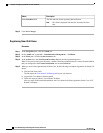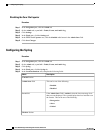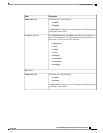
CHAPTER 47
Configuring Settings for Faults, Events, and Logs
This chapter includes the following sections:
• Configuring Settings for the Fault Collection Policy, page 701
• Configuring Settings for the Core File Exporter, page 703
• Configuring the Syslog, page 704
Configuring Settings for the Fault Collection Policy
Fault Collection Policy
The fault collection policy controls the lifecycle of a fault in a Cisco UCS domain, including when faults are
cleared, the flapping interval (the length of time between the fault being raised and the condition being cleared),
and the retention interval (the length of time a fault is retained in the system).
A fault in Cisco UCS has the following lifecycle:
1
A condition occurs in the system and Cisco UCS Manager raises a fault. This is the active state.
2
When the fault is alleviated, it enters a flapping or soaking interval that is designed to prevent flapping.
Flapping occurs when a fault is raised and cleared several times in rapid succession. During the flapping
interval, the fault retains its severity for the length of time specified in the fault collection policy.
3
If the condition reoccurs during the flapping interval, the fault returns to the active state. If the condition
does not reoccur during the flapping interval, the fault is cleared.
4
The cleared fault enters the retention interval. This interval ensures that the fault reaches the attention of
an administrator even if the condition that caused the fault has been alleviated and the fault has not been
deleted prematurely. The retention interval retains the cleared fault for the length of time specified in the
fault collection policy.
5
If the condition reoccurs during the retention interval, the fault returns to the active state. If the condition
does not reoccur, the fault is deleted.
Cisco UCS Manager GUI Configuration Guide, Release 2.0
OL-25712-04 701


















